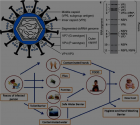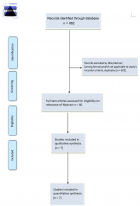Abstract
Research Article
How Bruguiera gymnorhizza seedlings respond to climate change induced salinity rise?
Prosenjit Pramanick, Subrata Trivedi, Sufia Zaman and Abhijit Mitra*
Published: 22 September, 2017 | Volume 1 - Issue 1 | Pages: 047-052
A study was undertaken during August 2017 to evaluate the effect of salinity on chlorophyll a, chlorophyll b, total chlorophyll, and carotenoid and proline contents of hydroponically grown seedlings of Bruguiera gymnorhizza. The primary aim was to observe its tolerance to changing salinity. The selected seedlings were exposed to five different salinity levels (2,5,10,15 and 20psu) for a period of 30 days and observations were done at a regular interval of 7,14,21 and 30 days respectively. The concentrations of chlorophyll exhibited significant positive correlations with salinity (p<0.01). The chlorophyll a:b ratio in the plant varied between 2.39 to 3.71 throughout the period of investigation. The salinity fluctuation did not affect the carotenoid level and proline content in the leaves of the species as evidenced from the insignificant r values. The results show that Bruguiera gymnorhizza of Indian Sundarbans region can tolerate and adapt to high saline condition as witnessed in the central sector of the deltaic complex around the Matla River.
Read Full Article HTML DOI: 10.29328/journal.aac.1001005 Cite this Article Read Full Article PDF
References
- Mangrove regeneration and management. In: AKF Hoque, 1995. Mimeograph. 1997.
- Davis JH. The Ecology and Geological Role of Mangroves in Florida. Pap Tortugas Lab. 1940; 32: 303-412. Ref.: https://goo.gl/5aVa4k
- Mitra A, Banerjee K, Bhattacharyya DP. The other face of mangroves. Department of Environment. 2004.
- Takemura T, Hanagata N, Sugihara K, Baba S, Karube I, et al. Physiological and biochemical responses to salt stress in the mangrove, Bruguiera gymnorrhiza. Aquatic Botany. 2000; 68: 15-28. Ref.: https://goo.gl/YMaFBS
- Parida AK, Das AB, Mohanty P. Defense potentials to NaCl in a mangrove, Bruguiera parviflora: differential changes of isoforms of some antioxidative enzymes. Journal of Plant Physiology. 2004; 161: 531-542. Ref.: https://goo.gl/31anu2
- Santiago LS, Lau TSP, Melcher J, Steele OC, Goldstein G. Morphological and physiological responses of Hawaiian Hibiscus tiliaceus population to light and salinity. International Journal of Plant Science. 2000; 161: 99-106. Ref.: https://goo.gl/1Ciw75
- Parida AK, Das AB, Mittra B. Effects of salt on growth, ion accumulation, photosynthesis and leaf anatomy of the mangrove Bruguiera parviflora. Trees-Structure and Function. 2004; 18: 167-174. Ref.: https://goo.gl/TTwKue
- Parida AK, Das AB, Mittra B. Effects of NaCl stress on the structure, pigment complex composition and photosynthetic activity of mangrove Bruguiera parviflora chloroplasts. Photosynthetica. 2003; 41: 191-200. Ref.: https://goo.gl/zF3XRX
- Tanaka Y, Fukuda A, Nakamura A, Yamada A, Saito T. Molecular cloning and characterization of mangrove Na+/H+ antiporter cDNA. Plant Cell Physiology. 2000; 41: 27.
- Hotta M, Nemoto S, Mimura T. Re-evaluation of role of vacuole during salt adaptation in higher plant cells. Plant Cell Physiology. 2000; 41: 79.
- Porra RJ, Thompson WA, Kriendemann PE. Determination of accurate extinction coefficients and simultaneous equations for assaying chlorophyll a and b extracted with four different solvents: verification of the concentration of chlorophyll standards by atomic absorption spectroscopy. Biochimca Biophysics Acta. 1989; 975: 384-394. Ref.: https://goo.gl/x4GYSU
- Arnon DI. Copper enzymes in isolated chloroplasts, polyphenol oxidase in Beta vulgaris. Plant Physiology. 1949; 24: 1-15. Ref.: https://goo.gl/pksav9
- Bates LS, Waldren RP, Teare ID. Rapid determination of free proline for water-stress studies. Plant Soil. 1973; 39: 205-207. Ref.: https://goo.gl/hxsXPe
- Sokal RR, Rohlf FJ. The Principles and Practice of Statistics in Biological Research. Biometry. 1995; 887.
- Mitra A, Gangopadhyay A, Dube A, Schmidt CK, Banerjee K. Observed changes in water mass properties in the Indian Sundarbans (Northwestern Bay of Bengal) during 1980 - 2007. Current Science. 2009; 97: 1445-1452. Ref.: https://goo.gl/NnTykA
- Clough BF. Effect of nutrient supply on photosynthesis in mangroves. In: L.J. Bhosale (ed.) The Mangroves. Proc Natl Symp Biol Util Cons. 1985; 80-88.
- Mishra S, Das AB. Effect of NaCl on leaf salt secretion and antioxidative enzyme level in roots of a mangrove, Aegiceras corniculatum. Indian Journal of Experimental Biology. 2003; 41: 160-166. Ref.: https://goo.gl/oQAjxE
- Netondo GW, Onyango JC, Beck E. Sorghum and salinity: I. Response of growth, water relations and ion accumulation to NaCl salinity. Crop Science. 2004; 44: 797-805. Ref.: https://goo.gl/Ct4DvH
- Connor DJ. Growth of grey mangrove (Avicennia marina) in nutrient culture. Biotropica. 1969; 1: 36-40. Ref.: https://goo.gl/JdmXx4
- Downton WJS. Growth and osmotic relations of the mangrove Avicennia marina, as influenced by salinity. Australian Journal of Plant Physiology. 1982; 9: 519-528. Ref.: https://goo.gl/3kTsQ9
- Burchett MD, Field CD, Pulkownik A. Salinity, growth and root respiration in the grey mangrove Avicennia marina. Physiologia Plantarum. 1984; 60: 113-118. Ref.: https://goo.gl/trHSZ7
- Clough BF. Growth and salt balance of the mangroves Avicennia marina (Forsk.) Vierh, and Rhizophora slylosa Griff. in relation to salinity. Australian Journal of Plant Physiology. 1984; 11: 419-430. Ref.: https://goo.gl/cvy3UR
- Chaudhuri AB, Choudhury A. Mangroves of the Sundarbans. 1994; 1: 284. Ref.: https://goo.gl/wf1tQA
- Gadallah MAA. Effects of proline and glycinebetaine on Vicia faba in response to salt stress. Biologia Plantarum. 1999; 42: 249-257. Ref.: https://goo.gl/QbLXJG
- Agastian P, Kingsley SJ, Vivekanandan M. 2000. Effect of salinity on photosynthesis and biochemical characteristics in mulberry genotypes. Photosynthetica. 2000; 38: 287-290. Ref.: https://goo.gl/cYqKxh
- Lee TM, Liu CH. Correlation of decreases calcium contents with proline accumulation in the marine green macroalga Ulva fasciata exposed to elevated NaCI contents in seawater. Journal of Experimental Botany. 1999; 50: 1855-1862. Ref.: https://goo.gl/ZwEzca
- Hernandez S, Deleu C, Larher F. Proline accumulation by leaf tissues of tomato plants in response to salinity. C R Acad Sci III. 2000; 323: 551-557. Ref. : https://goo.gl/pDxE7k
- Parida A, Das AB, Das P. NaCl stress causes changes in photosynthetic pigments, proteins and other metabolic components in the leaves of a true mangrove Bruguiera parviflora in hydroponic cultures. J Plant Biology. 2002; 45: 28-36. Ref.: https://goo.gl/7RNhA1
- Hazra S, Ghosh T, Dasgupta R, Sen G. Sea level and associated changes in Sundarbans. Science and Culture. 2002; 68: 309-321. Ref.: https://goo.gl/MQjaUe
- Lal M, Aggarwal D. Climate change and its impacts in India, Asia-Pacific Jr. Environment & Development. 2000; 7: 1-41.
- Ellison JC. How South Pacific mangroves may respond to predicted climate change and sea level rise. In Climate Change in the South Pacific: Impacts and Responses in Australia, New Zealand and Small Islands States. Kluwer Academic Publishers. 2000. Ref.: https://goo.gl/XUjMMY
- Ellison JC. Vulnerability of Fiji’s mangroves and associated coral reefs to climate change. Review for the World Wildlife Fund. 2004.
- Ellison JC, Stoddart DR. Mangrove ecosystem collapse during predicted sea-level rise: Holocene analogues and implications. J Coastal Research. 1991; 7: 151-165. Ref.: https://goo.gl/EcT6fv
Similar Articles
-
Neutralizing scFv Antibodies against Infectious Bursal Disease Virus Isolated From a Nlpa-Based Bacterial Display LibraryTianhe Li*,Bing Zhou*,Tingqiao Yu,Ning Li,Xiaochen Guo,Tianyuan Zhang,Jingzhuang Zhao,Liming Xu,Siming Li,Lei Ma,Tingting Li,Liangjun Ding,Mingzhe Sun,Deshan Li,Jiechao Yin. Neutralizing scFv Antibodies against Infectious Bursal Disease Virus Isolated From a Nlpa-Based Bacterial Display Library. . 2017 doi: 10.29328/journal.aac.1001001; 1: 001-011
-
Photocatalytic Degradation of Microcystins-LR over Mesoporous graphitic Carbon Nitride (mpg-CN)Laiyan Wu*,Jirong Lan,Anping Yang,Yanxi Zhao,Songbo Wang,Junjiang Zhu*. Photocatalytic Degradation of Microcystins-LR over Mesoporous graphitic Carbon Nitride (mpg-CN). . 2017 doi: 10.29328/journal.aac.1001002; 1: 012-22
-
The impact of geographical origin on specific properties of pine honeyIoannis K Karabagias*,Christos Nikolaou,Ilias Gatzias. The impact of geographical origin on specific properties of pine honey. . 2017 doi: 10.29328/journal.aac.1001003; 1: 023-031
-
Convenient route synthesis of some new benzothiazole derivatives and their pharmacological screening as antimicrobial agentsAhmed A Fadda*,Nanees N Soliman,Ahmed Fekri. Convenient route synthesis of some new benzothiazole derivatives and their pharmacological screening as antimicrobial agents. . 2017 doi: 10.29328/journal.aac.1001004; 1: 032-046
-
How Bruguiera gymnorhizza seedlings respond to climate change induced salinity rise?Prosenjit Pramanick,Subrata Trivedi,Sufia Zaman,Abhijit Mitra*. How Bruguiera gymnorhizza seedlings respond to climate change induced salinity rise?. . 2017 doi: 10.29328/journal.aac.1001005; 1: 047-052
-
Synthesis of some new Schiff bases of Pharmaceutical InterestAjay Kumar,Shweta Verma,Arun K Mishra,Sushil Kumar*. Synthesis of some new Schiff bases of Pharmaceutical Interest. . 2017 doi: 10.29328/journal.aac.1001006; 1: 053-056
-
Retrosynthesis analysis; a way to design a retrosynthesis map for Pyridine and pyrimidine ringSamar S Fatahala*. Retrosynthesis analysis; a way to design a retrosynthesis map for Pyridine and pyrimidine ring. . 2017 doi: 10.29328/journal.aac.1001007; 1: 057-060
-
Combinatorial Therapeutic Approaches to DNA/RNA and Benzylpenicillin (Penicillin G), Fluoxetine Hydrochloride (Prozac and Sarafem), Propofol (Diprivan), Acetylsalicylic Acid (ASA) (Aspirin), Naproxen Sodium (Aleve and Naprosyn) and Dextromethamphetamine Nanocapsules with Surface Conjugated DNA/RNA to Targeted Nano Drugs for Enhanced Anti-Cancer Efficacy and Targeted Cancer Therapy Using Nano Drugs Delivery SystemsAlireza Heidari*,Christopher Brown. Combinatorial Therapeutic Approaches to DNA/RNA and Benzylpenicillin (Penicillin G), Fluoxetine Hydrochloride (Prozac and Sarafem), Propofol (Diprivan), Acetylsalicylic Acid (ASA) (Aspirin), Naproxen Sodium (Aleve and Naprosyn) and Dextromethamphetamine Nanocapsules with Surface Conjugated DNA/RNA to Targeted Nano Drugs for Enhanced Anti-Cancer Efficacy and Targeted Cancer Therapy Using Nano Drugs Delivery Systems. . 2017 doi: 10.29328/journal.aac.1001008; 1: 061-069
-
Impact of alloimmunization on transfusion-dependent patientsSurapon Tangvarasittichai*. Impact of alloimmunization on transfusion-dependent patients. . 2017 doi: 10.29328/journal.aac.1001009; 1: 070-082
-
The Role of Tau Protein in DiseasesBhaskar C Das*,Sribidya Pradhan,Devi Prasana Ojha,Arpita Das,Narayan S Hosmane,Sasmita Das. The Role of Tau Protein in Diseases. . 2018 doi: 10.29328/journal.aac.1001010; 2: 001-016
Recently Viewed
-
Sinonasal Myxoma Extending into the Orbit in a 4-Year Old: A Case PresentationJulian A Purrinos*, Ramzi Younis. Sinonasal Myxoma Extending into the Orbit in a 4-Year Old: A Case Presentation. Arch Case Rep. 2024: doi: 10.29328/journal.acr.1001099; 8: 075-077
-
Timing of cardiac surgery and other intervention among children with congenital heart disease: A review articleChinawa JM*,Adiele KD,Ujunwa FA,Onukwuli VO,Arodiwe I,Chinawa AT,Obidike EO,Chukwu BF. Timing of cardiac surgery and other intervention among children with congenital heart disease: A review article. J Cardiol Cardiovasc Med. 2019: doi: 10.29328/journal.jccm.1001047; 4: 094-099
-
Advancing Forensic Approaches to Human Trafficking: The Role of Dental IdentificationAiswarya GR*. Advancing Forensic Approaches to Human Trafficking: The Role of Dental Identification. J Forensic Sci Res. 2025: doi: 10.29328/journal.jfsr.1001076; 9: 025-028
-
Scientific Analysis of Eucharistic Miracles: Importance of a Standardization in EvaluationKelly Kearse*,Frank Ligaj. Scientific Analysis of Eucharistic Miracles: Importance of a Standardization in Evaluation. J Forensic Sci Res. 2024: doi: 10.29328/journal.jfsr.1001068; 8: 078-088
-
Toxicity and Phytochemical Analysis of Five Medicinal PlantsJohnson-Ajinwo Okiemute Rosa*, Nyodee, Dummene Godwin. Toxicity and Phytochemical Analysis of Five Medicinal Plants. Arch Pharm Pharma Sci. 2024: doi: 10.29328/journal.apps.1001054; 8: 029-040
Most Viewed
-
Evaluation of Biostimulants Based on Recovered Protein Hydrolysates from Animal By-products as Plant Growth EnhancersH Pérez-Aguilar*, M Lacruz-Asaro, F Arán-Ais. Evaluation of Biostimulants Based on Recovered Protein Hydrolysates from Animal By-products as Plant Growth Enhancers. J Plant Sci Phytopathol. 2023 doi: 10.29328/journal.jpsp.1001104; 7: 042-047
-
Sinonasal Myxoma Extending into the Orbit in a 4-Year Old: A Case PresentationJulian A Purrinos*, Ramzi Younis. Sinonasal Myxoma Extending into the Orbit in a 4-Year Old: A Case Presentation. Arch Case Rep. 2024 doi: 10.29328/journal.acr.1001099; 8: 075-077
-
Feasibility study of magnetic sensing for detecting single-neuron action potentialsDenis Tonini,Kai Wu,Renata Saha,Jian-Ping Wang*. Feasibility study of magnetic sensing for detecting single-neuron action potentials. Ann Biomed Sci Eng. 2022 doi: 10.29328/journal.abse.1001018; 6: 019-029
-
Pediatric Dysgerminoma: Unveiling a Rare Ovarian TumorFaten Limaiem*, Khalil Saffar, Ahmed Halouani. Pediatric Dysgerminoma: Unveiling a Rare Ovarian Tumor. Arch Case Rep. 2024 doi: 10.29328/journal.acr.1001087; 8: 010-013
-
Physical activity can change the physiological and psychological circumstances during COVID-19 pandemic: A narrative reviewKhashayar Maroufi*. Physical activity can change the physiological and psychological circumstances during COVID-19 pandemic: A narrative review. J Sports Med Ther. 2021 doi: 10.29328/journal.jsmt.1001051; 6: 001-007

HSPI: We're glad you're here. Please click "create a new Query" if you are a new visitor to our website and need further information from us.
If you are already a member of our network and need to keep track of any developments regarding a question you have already submitted, click "take me to my Query."

















































































































































